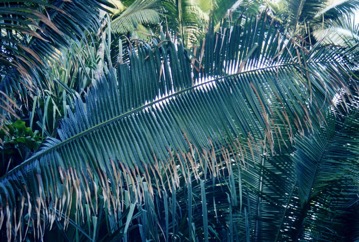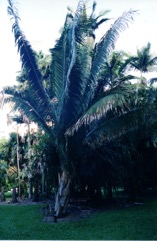Babasu oil palm

It is a tropical plant. It grows in the lowlands in hot tropical monsoonal climates. It grows in forest and open areas. It grows in areas with 1200 mm of rain per year. In the Cairns Botanical Gardens. (As Orbigyna barbosiana). In Townsville palmetum.
Also known as:
Aguacu, Aguassu, American oil palm, Babacu palm, Babassu, Bauacu, Coco-de-macaco, Coco-naia, Coco-pindoba, Cusi, Cusino, Guaguaco, Guaguazu, Iba, Motacuchi, Palem minyak babasu, Uauacu, Xebinihua, Xeni
Synonyms
- Attalea apoda Burret
- Attalea camposportoana Burret
- Attalea lydiae (Drude)Barb. Rodr.
- Attalea pixuna Barb. Rodr.
- Attalea spectabilis var. polyandra Drude
- Orbignya barbosiana Burret
- Orbignya huebneri Burret
- Orbignya lydiae Drude
- Orbignya macropetala Burret
- Orbignya martiana Barb. Rodr.
- Orbignya oleifera Burret
- Orbignya phalerata Mart.
- Orbignya pixuna (Barb.Rodr.)Barb.Rodr.
- Orbignya speciosa (Mart.) Barb. Rodr., nom. illeg.
Edible Portion
- Oil, Fruit, Nuts, Seeds, Palm heart, Cabbage, Sap
Where does Babasu oil palm grow?
Found in: Amazon, Asia, Australia, Bolivia, Brazil, Guiana, Guianas, Guyana, Indonesia, Mexico, Peru, SE Asia, South America, Suriname, United States
Notes: There are between (22) 30-71 Attalea species. Some authorities divide them among Attalea, Orbignya, Scheela and Maximiliana.
Status: It is a very important crop in Northern Brazil.
Growing Babasu oil palm
Cultivation: Plants are grown from seed. The ripe fruit are harvested and can be sown directly as seed. The seed only remain viable for a short time. They sprout after 4-6 months.
Edible Uses: The kernel of the nut is used to extract an edible oil. The kernels are eaten as a snack. The watery contents are used as a drink. Sap from the stem produces a palm wine. The palm heart is eaten. Ashes from the burnt stem are used as a salt substitute. The flour is mixed with milk and sugar to produce a chocolate like drink.
Production: The palms start to flower in the tenth year. They can live for 200 years. It produces 2-6 fruiting clusters each year. The kernel is 66% oil. In Bolivia there are an average of 182-211 trees per hectare. Fruit yields are 2456-2624 kg per hectare.
Nutrition Info
per 100g edible portion| Edible Part | Energy (kcal) | Protein (g) | Iron (mg) | Vitamin A (ug) | Vitamin c (mg) | Zinc (mg) | % Water |
|---|---|---|---|---|---|---|---|
| Fruit | - | - | - | - | - | - | |
| Nuts | - | - | - | - | - | - | |
| Palm heart | - | - | - | - | - | - | |
| Sap | - | - | - | - | - | - |
Babasu oil palm Photos



References
Balick, M.J. and Beck, H.T., (Ed.), 1990, Useful palms of the World. A Synoptic Bibliography. Colombia p 53 (As Orbignya martiana), 54, 63 (As Orbignya martiana), 64, 125 (As Orbignya oleifera), 143 (As Orbignya martiana), 157 (As Orbignya phalerata), 209 (As Orbignya martiana), 311 (As Orbignya phalerata), 390 (As Orbignya speciosa), 396 (As Orbignya martiana), 397, 399, 535, 555,
Bortolotto, I. M., et al, 2018, Lista preliminar das plantas alimenticias nativas de Mato Grosso do Sul, Brasil. Iheringia, Serie Botanica, Porto Alegre, 73 (supl.):101-116
Etkin, N.L. (Ed.), 1994, Eating on the Wild Side, Univ. of Arizona. p 121, 140 (As Orbignya phalerata)
Facciola, S., 1998, Cornucopia 2: a Source Book of Edible Plants. Kampong Publications, p 30 (As Orbignya martiana)
Glassman, A Taxonomic Treatment of the Palm Subtribe Attaleinae (Tribe Cocoeae). p 93 (As Orbignya phalerata)
Grandtner, M. M. & Chevrette, J., 2013, Dictionary of Trees, Volume 2: South America: Nomenclature, Taxonomy and Ecology. Academic Press p 52
Haynes, J., & McLaughlin, J., 2000, Edible palms and Their Uses. University of Florida Fact sheet MCDE-00-50-1 p 3
Henderson, A., Galeano, G and Bernal, R., 1995, Field Guide to the Palms of the Americas. Princeton. p 164
Hunter, D., et al, 2019, The potential of neglected and underutilized species for improving diets and nutrition. Planta (2019) 250:709-729
Janick, J. & Paul, R. E. (Eds.), 2008, The Encyclopedia of Fruit & Nuts. CABI p 92
Johnson, D.V., 1998, Tropical palms. Non-wood Forest products 10. FAO Rome. p 116
Kermath, B. M., et al, 2014, Food Plants in the Americas: A survey of the domesticated, cultivated and wild plants used for Human food in North, Central and South America and the Caribbean. On line draft. p 110
Leticia, Z., et al, 2015, Do Socioeconomic characteristics explain the knowledge and use of native food plants in semiarid environments in Northeastern Brazil? Journal of Arid Environments 115:53-61
Lorenzi, H., 2002, Brazilian Trees. A Guide to the Identification and Cultivation of Brazilian Native Trees. Vol. 01 Nova Odessa, SP, Instituto Plantarum p 300 (As Orbignya speciosa)
Lorenzi, H., Bacher, L., Lacerda, M. & Sartori, S., 2006, Brazilian Fruits & Cultivated Exotics. Sao Paulo, Instituto Plantarum de Estuados da Flora Ltda. p 87 (As Orbignya speciosa)
Marcia, M. J., et al, 2011, Palm Uses in Northwestern South America: A Quantitative Review. Bot. Rev. (2011) 77:462-570
Martin, F. W., et al, 1987, Perennial Edible Fruits of the Tropics. USDA Handbook 642 p 49 (As Orbignya martiana)
Menninger, E.A., 1977, Edible Nuts of the World. Horticultural Books. Florida p 139 (As Orbignya barbosiana)
Paz, F. S., et al, 2021, Edible Fruit Plant Species in the Amazon Forest Rely Mostly on Bees and Beetles as Pollinators. Journal of Economic Entomology, XX(XX), 2021, 1–13 (As Orbignya phalerata)
Riffle, R.L. & Craft, P., 2003, An Encyclopedia of Cultivated Palms. Timber Press. p 44, 266
Sukarya, D. G., (Ed.) 2013, 3,500 Plant Species of the Botanic Gardens of Indonesia. LIPI p 758
Syst. veg. 2:624. 1825
USDA, ARS, National Genetic Resources Program. Germplasm Resources Information Network - (GRIN). [Online Database] National Germplasm Resources Laboratory, Beltsville, Maryland. Available: www.ars-grin.gov/cgi-bin/npgs/html/econ.pl (10 April 2000)
van Roosmalen, M.G.M., 1985, Fruits of the Guianan Flora. Utrecht Univ. & Wageningen Univ. p 342
Vasquez, Roberto Ch. & Coimbra, German S., 1996, Frutas Silvestres Comestibles de Santa Cruz. p 158
Wickens, G.E., 1995, Edible Nuts. FAO Non-wood forest products. FAO, Rome. p 169 (Also as Orbignya oleifera and Orbignya martiana and Orbignya speciosa)
World Checklist of Useful Plant Species 2020. Royal Botanic Gardens, Kew
www.worldagroforestrycentre.org/treedb/ (As Orbignya phalerata)
Zambrana, P, et al, 2017, Traditional knowledge hiding in plain sight – twenty-first century ethnobotany of the Chácobo in Beni, Bolivia. Journal of Ethnobiology and Ethnomedicine (2017) 13:57